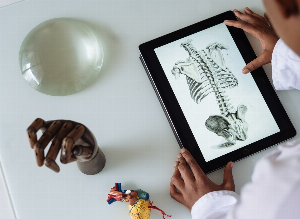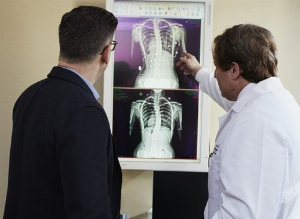Multiple myeloma: What follow-up care options are available?
Published Dec 13, 2021 • By Claudia Lima
Multiple myeloma, also called Kahler's disease, is a type of cancer that develops in the bone marrow. Multiple myeloma is more commonly diagnosed in the elderly, and it's cause remains unknown. Current treatments are not able to cure the disease.
How to live with multiple myeloma? What is the follow-up care for patients with multiple myeloma?
You will find all the answers in our article!

There are more than 30,000 new cases of multiple myeloma diagnosed in the US every year. It accounts for less than 2% of all new cancer cases. This cancer is characterized by the abnormal multiplication of plasma cells (white blood cells) in the bone marrow. Their excessive number disturbs the bone renewal balance, the bones become fragile which leads to fractures.
How is multiple myeloma treated?
Some asymptomatic patients do not require treatment, only medical supervision. This is called therapeutic abstention.
On the other hand, when symptoms are present, treatment plan includes chemotherapy, and can be supplemented by or associated with autologous stem cell transplantation (ASCT). This is possible for patients under 65.
To relieve the symptoms and frequent complications, some of which require urgent care, drug treatment is prescribed (analgesics, antibiotics, bisphosphonates), as well as transfusions and / or radiotherapy. The aim is to relieve pain, prevent infections, treat or prevent anemia and protect the bones.
The approach to treatment is multidisciplinary, the patient's care pathway is customized and is the subject of mutual agreement. Sometimes patients are offered participation in a clinical trial.
During treatment, the patient is accompanied by healthcare providers, in order to acquire self-care skills, prevent avoidable complications and improve or maintain his or her health, as well as quality of life, including that of the patient's family and/or friends. This is called TPE, therapeutic patient education.
There is a lot of advice given by doctors such as: drink regularly to avoid being dehydrated, notify healthcare providers about your condition before each medical imaging exam that requires the injection of iodinated contrast media, do not consult osteopaths or chiropractors without medical advice, avoid high-risk sports, avoid carrying heavy loads, adapt your diet if you are taking cortisone, wear compression stockings, have a good oral hygiene, do not take NSAIDs...
Although treatments can slow the progression of the disease and relieve its symptoms, multiple myeloma remains to this day an incurable disease. In fact, with varying delays depending on the patient, cancer eventually reappears, and it becomes necessary to start new treatment.
So how can we prevent a relapse?
What follow-up care after treatment for multiple myeloma?
Multiple myeloma is a disease that tends to become chronic, as it has regular relapses. Each relapse requires appropriate treatment. This is why patients with this condition need close follow-up medical care throughout their whole life.
Follow-up care aims at identifying any side effects associated with the treatment, detecting cancer recurrences, ensuring the patient's quality of life and facilitating professional reintegration for working patients.
Follow-up visits for multiple myeloma patients
Patients with multiple myeloma who have already received treatment and are in remission, are regularly invited to follow-up appointments. Their rhythm differs depending on the stage of the disease: the visits are frequent at the beginning, and then become more spaced out, that is, every 3 to 6 months.
These appointments include a clinical examination and additional examinations consisting of a blood test (complete blood count, calcium level, renal functions, etc.), a urine test, as well as recent skeletal x-rays control. Vaccination against influenza and pneumococcal infections must be up to date.
Prevention of and screening for other cancers
After multiple myeloma patients risk to develop other cancers such as acute leukemia or skin cancer. This risk is rather low, but it does exist.
Also, according to the national cancer screening program, patients aged 60 to 74 should be screened for bowel cancer every 2 years. Women aged 50 to 70 should also undergo a follow-up mammogram every 3 years.
Global medical care plan
Due to the fact that multiple myeloma affects various organs, it can cause complications such as pain, kidney failure, hematologic disorders and thromboembolic events, which may interact with the patient's already existing comorbidities. In addition, treatments for multiple myeloma provoke side effects, for example, the administration of Thalidomide® is associated with risks of thrombosis, neuropathy, skin reactions, bradycardia and syncopes, among others.
Psychological support
The emotional state of the patient and his or her caregivers is strongly impacted by the announcement of cancer diagnosis. In the case of multiple myeloma, asymptomatic patients may be subject to anxiety due to less frequent doctor's appointments. As for patients who are treated, one of the greatest fears is the fear of relapse, which is a source of great distress. Psychological support in these cases is invaluable .
Healthy lifestyle
To help them overcome the delayed side effects of treatment and the psychological impact of the disease, patients may be prescribed a specific program called Adapted Physical Activity. It allows them to improve the effectiveness of their therapy, reduce fatigue and sleeping disorders, increase concentration, and also maintain weight and muscle mass, in order to have a better response to treatment.
Multiple myeloma: signs of a relapse
It is essential to detect the slightest signs of complications related to a relapse or to a treatment's side effect. A relapse is evoked if:
1 / A monoclonal immunoglobulin peak is observed, that is to say, the presence of an increased amount of monoclonal immunoglobulin in the serum, which may suggest a malignant proliferation of plasma cells and / or
2 / The return of biological (the CRAB criteria) and clinical symptoms is observed. The most common clinical signs that should alert are:
- Pain in the bones or in the back,
- Loss of sensitivity in the feet/hands,
- Motor impairments,
- Unexplained fever,
- Nausea or vomiting
- Abnormally low or high urine output,
- Fatigue and / or shortness of breath,
- Respiratory, urinary or repeated infections,
- Bruising or bleeding.
Patients who experience these symptoms must see their doctor as soon as possible, and should be referred to a specialized team of healthcare providers.
This makes multiple myeloma a disease that can be treated several times.
Share your thoughts and questions with the community in the comments below!
Take care!
Sources :
Myélome multiple : définition, symptômes et traitements, sante-sur-le-net.com
Après le traitement d'un myélome multiple, vidal.fr
La prise en charge du myélome multiple, has-sante.fr
Guide affection de longue durée, myélome multiple, has-sante.fr
Qu'est-ce qu'un myélome, fondation-arc.org
Survie des personnes atteintes d'un cancer en France métropolitaine 1989-2018, Myélome multiple, santepubliquefrance.fr
Myélomes multiples, vivre avec et après la maladie, fondation-arc.org
Cancers du sang, myélome multiple, arcagy.org
Myélome multiple, sante.fr
Les outils pour accompagner le parcours personnalisé du patient, e-cancer.fr
Comments
You will also like

Multiple Myeloma: “I roll with the punches, stay active when I can, and rest when I need to.”
Apr 17, 2024

 Facebook
Facebook Twitter
Twitter

